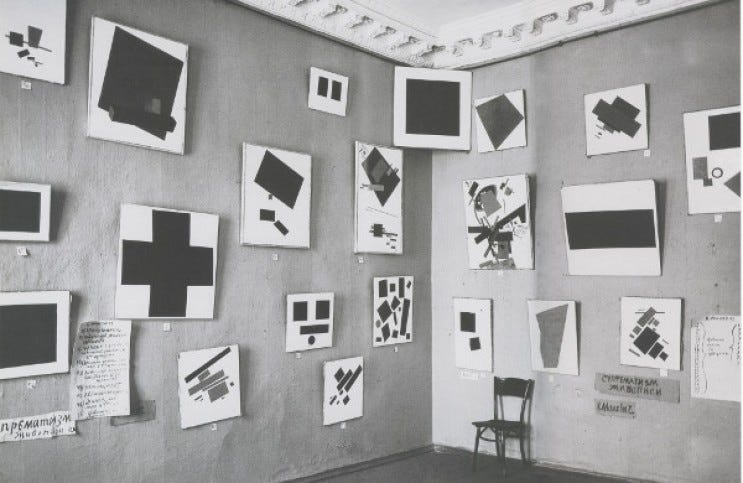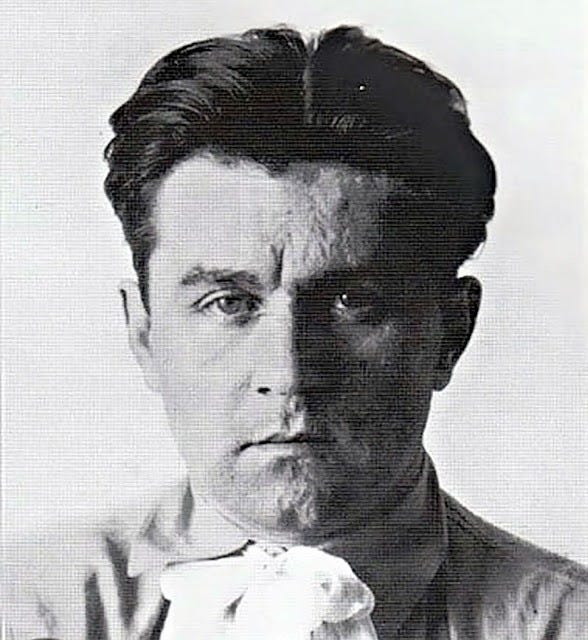Happy Sunday and welcome back to Giselle daydreams! Last month, I visited In the Eye of the Storm at the Royal Academy of Arts in London, and this inspired me to write about Russian and Ukrainian artists, which I haven’t covered yet.
Kazimir Malevich's Black Square is one of the most iconic and pivotal works in the history of Modern Art. Created in 1915, it is a simple black square painted on a white canvas. This piece is a cornerstone of the Suprematist movement, which Malevich founded. Suprematism emphasises basic geometric forms and pure colour, focusing on the supremacy of pure artistic feeling rather than representation.
As an avant-garde work, it embodies the spirit of experimentation and the desire to push the boundaries of what art can be, reflecting the dynamic cultural and political climate of the early 20th century. At the time Black Square was created and first exhibited, the world was in complete chaos. It was the midst of World War I, with ongoing unrest following the 1905 Russian Revolution, culminating in the Bolshevik uprising and the October Revolution of 1917. Malevich intended his work to encapsulate a new dawning age by not depicting reality.
When Black Square was first exhibited in the exhibition the Last Exhibition of Futurist Painting 0.10 in 1915 in St Petersburg (which had been renamed Petrograd during the Bolshevik times) he wrote in the handout accompanying the work:
Up until now there were no attempts at painting as such, without any attribute of real life… Painting was the aesthetic side of a thing, but never was original and an end in itself.
And in 1927, in his book The Non-Objective World, he wrote:
In the year 1913, trying desperately to free art from the dead weight of the real world, I took refuge in the form of the square.
Black Square is often seen as a radical departure from traditional art and has been interpreted as a symbol of the end of the old artistic conventions and the beginning of a new era in art. The painting features a single, solid black square positioned off-centre on a white canvas. The painting's emphasis on a simple geometric shape and a limited colour palette reflects Malevich’s interest in abstraction. The black square represents the essence of form, devoid of any representational content. By stripping away all non-essential elements, Malevich sought to distil art to its most fundamental components, questioning the need for complex imagery in conveying meaning. The simplicity of the composition is striking, with no other shapes, colours, or textures to distract from the central element. The stark contrast between the black square and the white background is meant to highlight the purity of the geometric form. The absence of colour, other than black and white, focuses attention on the form itself rather than any representational content.

Black Square is a cornerstone of the Suprematist movement, which was founded by Malevich. Suprematism sought to explore the supremacy of pure artistic feeling over the depiction of the physical world. Suprematism is characterised by its focus on basic geometric forms and a limited colour palette, aiming to transcend the constraints of representational art. Malevich painted four versions of the Black Square.
Malevich aimed to express a sense of spiritual and emotional purity, moving beyond the materialistic and representational aspects of art. The painting is often interpreted as a radical break from traditional art forms. By stripping away all representational elements and focusing solely on a geometric form, Malevich challenged existing norms and pushed the boundaries of what art could be. Malevich's work is linked to his broader theoretical writings on art. In his manifesto, he argued that art should not be concerned with depicting the physical world but should instead seek to express pure emotion and abstract concepts.
The black square can be interpreted as a symbol of the void or nothingness, prompting viewers to reflect on the concept of emptiness and the limits of visual representation. Malevich’s work often delves into metaphysical questions, challenging viewers to reconsider their understanding of art, reality, and perception. Malevich's work is also seen as a declaration of artistic freedom, breaking free from the constraints of traditional representation and allowing for the exploration of new artistic possibilities.
Black Square has been seen as a symbol of the avant-garde and a declaration of the artist's departure from traditional artistic conventions. It represents a new beginning in art, one that emphasises abstraction and the exploration of fundamental visual elements. The painting marks a radical departure from traditional art forms and practices. Its creation was a deliberate statement against the conventions of realistic and narrative art.
Black Square can also be seen as a critique of the past and an assertion of a new artistic and cultural identity. The painting emerged in the context of revolutionary change in Russia and reflects a broader desire for innovation and transformation.
The painting's reception has varied over time. Initially, it was met with shock and confusion, but it has since become a celebrated and influential piece, inspiring countless discussions and interpretations in the art world.
Black Square challenges viewers to engage with art on a fundamental level, questioning traditional notions of representation and exploring new ways of understanding and experiencing visual expression. Black Square remains a powerful and enigmatic piece, emblematic of the radical shifts in art that occurred in the early 20th century.
I hope you enjoyed today’s post. Please keep liking, commenting, subscribing and sharing. It helps the newsletter grow. If you would like to support this project and can afford to do so, please consider becoming a paid subscriber.
Giselle xx







Thank you for writing this story with the quality and care that Black Square deserves! Was so happy to read it!
Fascinating period of art history! Great read